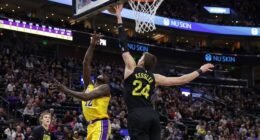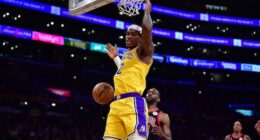
When LeBron and Chris Bosh joined Dwyane Wade in Miami to form the Heatles, they also immediately made the Finals in their first year as a unit, albeit losing to the Dallas Mavericks in six games, they still got there.
Heck, even when the Lakers signed Karl Malone and Gary Payton to play for peanuts on July 13th, 2003, that team limped its way to the Finals before Detroit obliterated them in five games.
So naturally when it came the Lakers turn to rinse and repeat the bring a couple superstars together and pray they’ll find a way to make it work formula, and they failed; the natural reaction was to overreact.
But correct me if I’m wrong – didn’t the Lakers finish the season 28-12 in a season where Mike Brown was fired after five games and three of LA’s future Hall of Famers were all hurt at one point or another (Kobe, Nash and Pau) and the other (Dwight Howard) just came off back surgery?
The ending to a season shouldn’t overshadow the obstacles the team had to overcome just to make the playoffs. Sometimes endings can be deceiving and they’re usually not really the ending. Being swept by the Western Conference champions without your best player is disappointing, but not all that surprising.
“I want him (Pau Gasol) here. He gives us the best chance to win titles. You bring Dwight back. Then we’re off and running,” Kobe also said at the exit interview. “You saw how well they played together at the end of the season, that puzzle finally got solved.”
Good teams take time to build, and even when they’re built, it takes an adjustment period for that group to excel as a unit. I know that’s a nascent concept since the late Dr. Jerry Buss bought the team and made it synonymous with immediate success, but just ask a fan of the 29 other teams in the league and I’m sure they can fill you in on the agonizing process.
A great example the 2013-14 Lakers can look to emulate is the run that the Indiana Pacers just made. Throughout their 19 games in the 2013 playoffs, they played to their strengths and forced other teams to adjust to them (with the exception to the final play of Game 1 when Frank Vogel didn’t have Hibbert on the floor, allowing LeBron James to get all the way to the basket for the game winning layup).
Not to mention three of out the four conference finalists of this year’s playoffs featured a prominent big man or two: Tim Duncan, Zach Randolph, Marc Gasol and Roy Hibbert.
The Pacers absolutely bullied the New York Knicks and the Miami Heat, two of the catalysts to the small ball revolution, coming within a game of making the finals with a traditional back to the basket center as their most important player.
Sure, he’s surrounded with more athletic wing players such as Paul George, Lance Stephenson and George Hill but you can’t tell me that the frontcourt of Hibbert and David West causes more headaches for an opponent than the tandem of Gasol and Howard.
Just for reference. Here’s a glance at how Dwight and Roy Hibbert stack up in terms of season averages this past year.
Hibbert: 11.9 PPG, 8.3 RPG, 2.6 BPG
Howard: 17.2 PPG 12.5 RPG and 2.5 BPG
Sometimes, analysis doesn’t need to overcomplicated and over-saturated with advanced statistics. If the Lakers manage to re-sign Dwight Howard and they have a tad more luck on the injury front in 2013-14, Kobe and co. should return to relevance.
It’s not only unfair to judge a project with such potential on its trial run, but the Lakers might not have any other choice but to pray that it pays off considering their salary cap situation.
I mean if Caterpie, the wimpiest looking Pokémon of all-time, is able to evolve into Butterfree with time, imagine what Steve Nash, Kobe Bryant, Pau Gasol and Dwight Howard can do with one more season together.
——————————————————————————————




